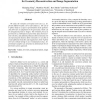Free Online Productivity Tools
i2Speak
i2Symbol
i2OCR
iTex2Img
iWeb2Print
iWeb2Shot
i2Type
iPdf2Split
iPdf2Merge
i2Bopomofo
i2Arabic
i2Style
i2Image
i2PDF
iLatex2Rtf
Sci2ools
SMI
2006
IEEE
2006
IEEE
Evolution of T-Spline Level Sets with Distance Field Constraints for Geometry Reconstruction and Image Segmentation
We study the evolution of T-spline level sets (i.e, implicitly defined T-spline curves and surfaces). The use of T-splines leads to a sparse representation of the geometry and allows for an adaptation to the given data, which can be unorganized points or images. The evolution process is governed by a combination of prescribed, data-driven normal velocities, and additional distance field constraints. By incorporating the distance field constraints we are able to avoid additional branches and singularities of the T-spline level sets without having to use re-initialization steps. Experimental examples are presented to demonstrate the effectiveness of our approach.
| Added | 12 Jun 2010 |
| Updated | 12 Jun 2010 |
| Type | Conference |
| Year | 2006 |
| Where | SMI |
| Authors | Huaiping Yang, Matthias Fuchs, Bert Jüttler, Otmar Scherzer |
Comments (0)

